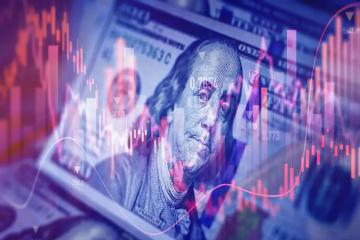In today's fast-paced financial environment, the dynamics surrounding the exchange rate between the US dollar and Japanese yen have become a focal point for investors worldwide
Advertisements
Each fluctuation triggers a wave of reactions and strategic recalibrations.
Earlier this week, the dollar-yen exchange rate embarked on a crucial journey, bravely confronting a formidable resistance level at 158.13. The significance of this threshold cannot be understated; it stands like a colossal mountain blocking further ascension, ultimately testing the currency's capability to surpass such barriersShould it breach this level, it faces an even tougher summit at 157.49, awaiting conquestOn the other side of the spectrum, support levels at 157.78 and 157.42 act like a safety net, cushioning the exchange rate's fluctuationsAs of January 15, at precisely 11:25 AM Beijing time, one US dollar was equal to 157.884 yenThis figure encapsulates a snapshot of the current market and serves as a critical reference point for investors looking to analyze potential future movements.
In a quiet session on January 14, the yen took on a calm demeanor akin to a poised dancer on the market stage, exhibiting only slight declines
Advertisements
The week saw no significant happenings within Japan that would sway the currency's course, leading to a tranquil landscape largely unperturbed by dramatic eventsYet, this tranquility might merely be the calm before the storm, as Wednesday's anticipated inflation data release from the United States looms largeInflation data plays a vital role in determining the health of an economy, wielding considerable influence over financial marketsThe market forecasts a modest uptick in December's Consumer Price Index (CPI), predicting an increase from November's 2.7% to 2.9%, while the core CPI is expected to remain steady at 3.3% for the third consecutive month.
Typically, such inflation reports can have a pronounced impact on interest rate expectations, acting as keys to unlock or lock the doors to potential monetary policy adjustments
Advertisements
However, the December inflation rate may not garner as much attention as in previous months, given the recent dip in market expectations for interest rate cuts from the Federal ReserveSince the meeting last December, the Fed has worked intensely to cool down rate cut anticipations, sending steady signals into the marketThe prevailing sentiment suggests that a cut may not arrive until the first quarter of 2025, with predictions for less than a 3% chance of a 25 basis-point cut during the January 29 meeting, and only about a 20% probability for such a move in MarchThis evolving landscape stems from a stabilizing inflation rate and a robust job market, providing solid ground for the Fed’s deliberations regarding monetary policies.
Meanwhile, on the horizon, the Bank of Japan has also released updates, increasing the complexity of the market's outlook
Deputy Governor Masayoshi Amamiya mentioned that discussions regarding interest rate hikes will take place during the meeting on January 24. Historically, the Bank of Japan has been secretive regarding its interest rate plans, creating an air of mystery that compels investors to sift through various clues for any insight into future policiesThis element of uncertainty undeniably heightens the drama surrounding the forthcoming meeting, making each discussion a pivotal event for market dynamicsAmamiya’s statements haven’t made any definitive declarations about the Bank’s direction, but he echoed Governor Kazuo Ueda’s sentiments regarding steady wage growth and the complexities of U.Strade policiesThe former suggests that Japan's economic foundation is strengthening, potentially supporting the case for an interest rate hike; the latter hints at external risks that may compel cautious assessments when formulating monetary strategies.
From a technical perspective, the dollar's recent test of the 158.13 resistance indicates a short-term bullish momentum, yet the upper resistance of 158.49 stands as a significant barrier to further appreciation

The safety nets below, at 157.78 and 157.42, establish a relatively stable zone for any market fluctuationsAs of 01:24 Beijing time, the dollar-yen rate stood at 158.098, reflecting a 0.40% increase, indicative of the market's current volatilityInvestors are encouraged to analyze these technical indicators alongside foundational information to better navigate the currency's trajectory.
In summary, the movement of the dollar-yen exchange rate is shaped by a multitude of interlinking factorsChief among them are the monetary policies of both nationsThe expectations surrounding the Federal Reserve's potential interest rate cuts and the suppressed discussions of the Bank of Japan's anticipated rate hikes will inherently affect the exchange rate's future
Additionally, inflation figures serve as barometers for economic conditions, wielding influence over rate expectations, which in turn, impact the exchange rate trajectoryFurthermore, market sentiments cannot be overlooked; the collective emotions and judgments of investors shape a significant force that drives the exchange rate in varying directions.
In this complex market landscape, it is imperative for investors to remain vigilant, closely monitoring the upcoming U.Sinflation data release as well as the January 24 meeting outcomes from the Bank of JapanThese crucial events stand poised to be pivotal turning points for the dollar-yen exchange rate, potentially casting long shadows over market dynamicsA keen and adaptive approach is essential for success, as timely adjustments to investment strategies could make the difference in this intricate game of financial chess.
